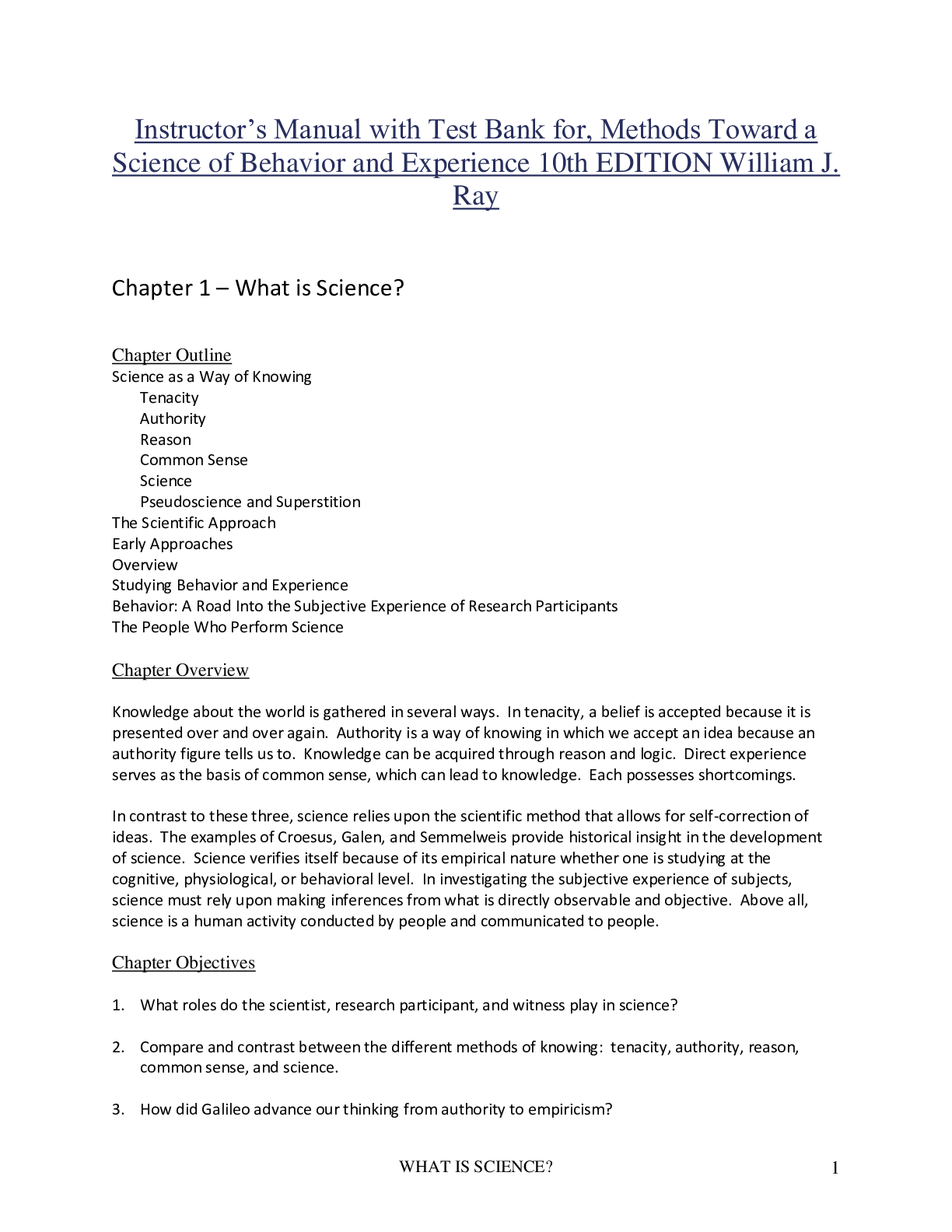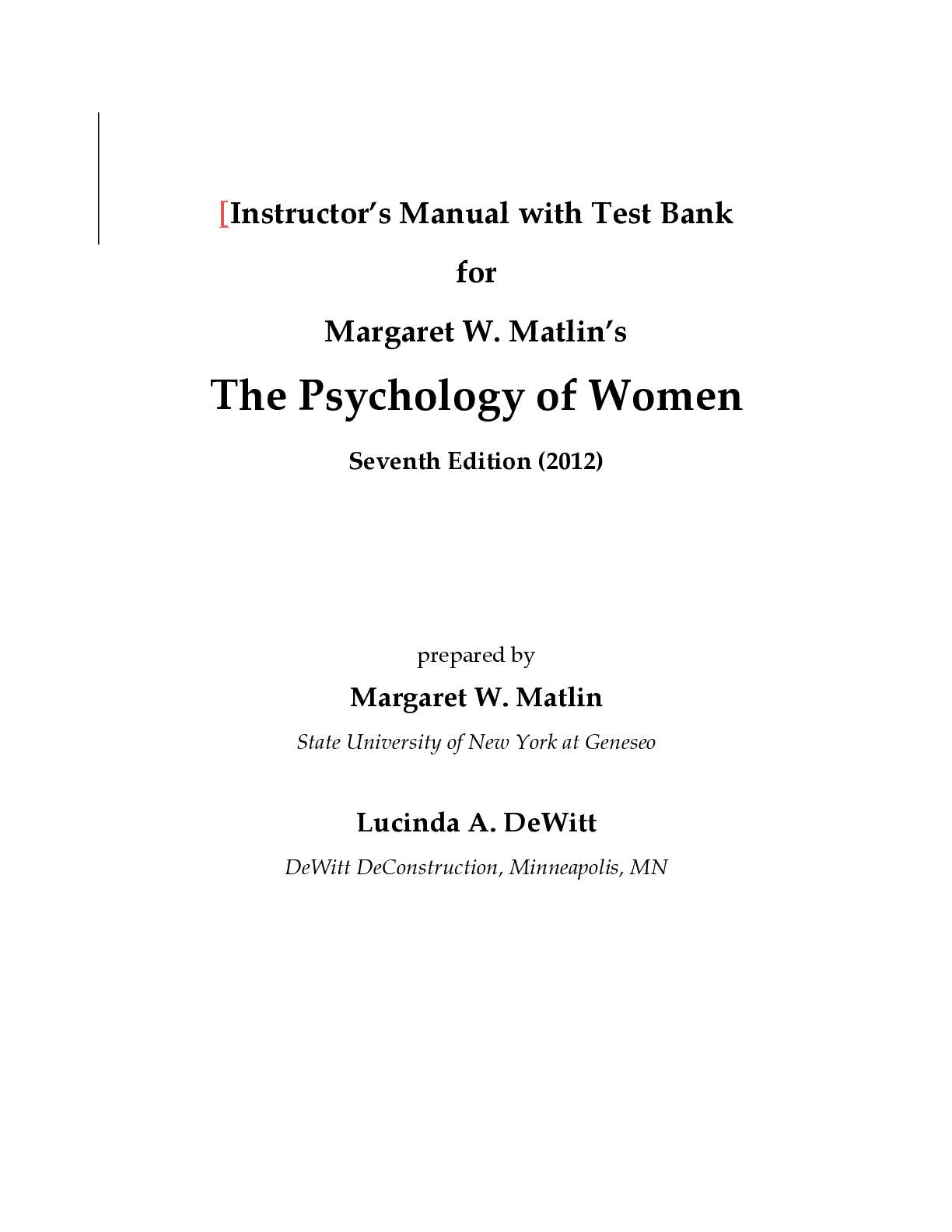Psychology > TEST BANK > Instructor’s Manual with Test Bank for Margaret W. Matlin’s The Psychology of Women Seventh Edit (All)
Instructor’s Manual with Test Bank for Margaret W. Matlin’s The Psychology of Women Seventh Edition
Document Content and Description Below
Instructor’s Manual with Test Bank for Margaret W. Matlin’s Psychology of Women, 7e (2012) Contents Syllabus from Dr. Matlin’s Course 1 Research Project Handout 8 Details About Research Projects... 13 Chapter Outlines 18 Test Bank 127 1 Introduction 127 2 Gender Stereotypes and Other Gender Biases 151 3 Infancy and Childhood 171 4 Adolescence 194 5 Gender Comparisons in Cognitive Abilities and Attitudes About Achievement 213 6 Gender Comparisons in Social and Personality Characteristics 232 7 Women and Work 248 8 Love Relationships 269 9 Sexuality 288 10 Pregnancy, Childbirth, and Motherhood 307 11 Women and Physical Health 324 12 Women and Psychological Health 343 13 Violence Against Women 361 14 Women and Older Adulthood 378 15 Moving Onward . . . 395 Instructor’s Manual with Test Bank for Margaret W. Matlin’s The Psychology of Women Seventh Edition (2012) prepared by Margaret W. Matlin State University of New York at Geneseo Lucinda A. DeWitt DeWitt DeConstruction, Minneapolis, MNInstructor’s Manual with Test Bank for Margaret W. Matlin’s Psychology of Women, 7e (2012) Contents Syllabus from Dr. Matlin’s Course 1 Research Project Handout 8 Details About Research Projects 13 Chapter Outlines 18 Test Bank 127 1 Introduction 127 2 Gender Stereotypes and Other Gender Biases 151 3 Infancy and Childhood 171 4 Adolescence 194 5 Gender Comparisons in Cognitive Abilities and Attitudes About Achievement 213 6 Gender Comparisons in Social and Personality Characteristics 232 7 Women and Work 248 8 Love Relationships 269 9 Sexuality 288 10 Pregnancy, Childbirth, and Motherhood 307 11 Women and Physical Health 324 12 Women and Psychological Health 343 13 Violence Against Women 361 14 Women and Older Adulthood 378 15 Moving Onward . . . 395Instructor’s Manual with Test Bank for Margaret W. Matlin’s Psychology of Women, 7e (2012)Instructor’s Manual with Test Bank for Margaret W. Matlin’s Psychology of Women, 7e (2012) 1 of 381 SYLLABUS FROM DR. MARGARET W. MATLIN’S COURSE My syllabus changes somewhat from one semester to the next, but the syllabus below is the version I used in Fall Semester, 2010. (However, the textbook for that course was the 6th edition.) I think it’s important for a syllabus to include a brief description of the course, as well as the goals. From the first page of the syllabus, students should be able to understand the general scope of the course. You can find several additional syllabi for courses on the Psychology of Women or the Psychology of Gender on the website for the Society for the Teaching of Psychology (Division 2 of the American Psychological Association): Scroll down the list of courses on the right-hand side, and you will find the topic “Women and Gender.” Additional note: Psychology of Women Quarterly now includes a “Teaching Section” in each issue. It features between one and three short articles in each issue, which focus on topics related to women and gender, such as critical thinking, social class, social justice advocacy. I am the current editor of this Teaching Section; please email me at , if you have an idea about a potential article related to this teaching! On the first day of class, students also receive a description of the Psychology of Women Research Project, an important component of my course. Later in this document you can find a description of this project, as well as some details about the project.Instructor’s Manual with Test Bank for Margaret W. Matlin’s Psychology of Women, 7e (2012) 2 of 381 Psychology of Women Dr. Margaret W. Matlin Psychology 308 Department of Psychology Fall, 2010 SUNY Geneseo SYLLABUS COURSE DESCRIPTION The purpose of this course is to examine the lives of girls and women. We will include topics such as gender stereotypes, the development of gender roles, gender comparisons, women and work, love relationships, sexuality, women’s physical and mental health, violence against women, and women in later adulthood. Students who take this course should acquire a better understanding about girls, women, and gender in North America. As the course instructor, I’m hopeful that each of you will work toward the following goals: 1. To understand the relevant information about the lives of girls and women—as well as gender—with a particular emphasis on the complexity of the issues. 2. To develop critical-thinking skills, so that you can evaluate both the research in professional journals and information described in the popular media. 3. To know how to design your own psychology research project, to conduct the research, and to write an appropriately professional summary of your own research, emphasizing the potential methodological flaws and strengths in your study. 4. To explore your own ideas and attitudes about gender, appreciating that we do not need to be constrained by our culture’s traditional gender roles. 5. To appreciate the inequalities that many individuals face, based on social categories other than gender. These categories include age, disability, sexual orientation, ethnicity, religion, social class, and country of residence. We will also consider some information about inequalities in other cultures, outside North America. READING MATERIALS Our textbook for the course will be: Matlin, M. W. (2008). The psychology of women (6th ed.). Belmont, CA: Cengage/Wadsworth. You’ll need to use this 6th edition, which has a brown and gold cover and a photo of a girl, a young woman, and an older woman. This edition has more than 1,400 new references that were published since the earlier 5th edition, as well as many concepts and research-based studies that were not discussed in the 5th edition. (Do not use the 5th edition, which has a purple cover and aInstructor’s Manual with Test Bank for Margaret W. Matlin’s Psychology of Women, 7e (2012) 3 of 381 photo of three middle-aged women, and do not use any shortened paperback version of the textbook.) Your textbook is one I have written, and you’ll need to understand the material in the textbook in order to do well in the course. You will not be able to achieve this knowledge from a superficial reading of the chapters. You should master the terminology and concepts in the textbook. During the lectures and class discussions, I will assume that you are familiar with this information. However, if any part of the textbook is not clear, please let me know! Then we can discuss that topic in class! ** You will also receive one journal article, which you will read and analyze for class discussion. (See below for details.) OFFICE HOURS My scheduled office hours are Monday, 1:15-2:15 p.m., Tuesday, 11:30-12:30, and Thursday, 11:30-12:45. I may need to reschedule an occasional office hour on days when other commitments arise. If my office hours are not convenient, please check with me, and we can schedule an alternate time! My office is in Sturges, Room 121C (main floor, right-hand side). I check my e-mail frequently, usually until about 9 p.m. (). Before contacting me, be sure to check the syllabus and project description to be certain that your question is not answered there. Please include the term “Psychology of Women” in the subject of your e-mail message. Also, proofread the message to make sure that your question is clear. This way, I will not delete your email by mistake, and I can quickly provide you with the most helpful response! You can also leave a brief message on my voice mail (5214). I will check my voice-mail messages several times each week, but not as often as e-mail. REQUIREMENTS 1. Examinations: You will have two 75-minute-long exams, as well as a comprehensive final. The format for all tests will be a combination of essays and multiple-choice questions. Each 75-minute exam will be worth about 50-55 points, and the final exam (about 2 hours long) will be worth about 75 points. The final exam is cumulative, with an emphasis on the last part of the course. 2. Research Paper: The independent research paper is described in detail on a second handout, entitled “Psychology of Women Research Project.” This paper will be worth 55 points. Your preview for your independent research project will be due on Monday, October 18. In one to two pages, youInstructor’s Manual with Test Bank for Margaret W. Matlin’s Psychology of Women, 7e (2012) 4 of 381 should state at least two of your hypotheses. Also describe how and where you plan to locate the participants (or the media resources) for your study. The preview must be double-spaced and printed on only one side of the paper, so that I can make comments that you’ll be able to read. In a couple of weeks, I’ll provide details about how to prepare this preview. The paper itself will be due at the beginning of class on Monday, November 22. (One point will be subtracted for each day that either the paper preview or the paper is late.) You must turn in a paper in order to pass this course. The purpose of this paper is to help you understand research techniques, increase your critical-thinking skills, and write professionally. You are not required to see me to discuss the project. However, students who meet with me sometime in September tend to develop the best projects. Print two copies of your paper. Give me a copy that is printed on only one side of the paper. (Again, this allows me to comment in detail, and it will therefore be easier for you to read my comments.) Your second copy can be back-to-back. I’ll return to you the original version with the comments, and you can give me the back-to-back version for my files. The last day on which the paper will be accepted is Thursday, December 2, at 11:30 a.m. This final deadline is firm, so please respect it. 3. Journal Article: You will read one article from the professional journal Sex Roles. You’ll receive a short list of questions about the article, which you must answer (typed, not handwritten). This assignment will be due on October 25. You will need to write at least 2/3 of a page (single spaced) in order to provide enough detail about the research. Make two printed copies of your answers, one to keep for discussion, and one to hand in at the beginning of class, so that I can note that you turned it in. We will discuss the article in small groups on the day that the assignment is due. You will not receive a letter grade on this assignment; you are handing in your answers to the questions to demonstrate that you have read and thought about the article. I will also ask questions about the article on your exams. One point will be subtracted for every day that each assignment is late. In order to pass the course, you must hand in the journal-article summary no later than 10 days after its due date. The purpose of this assignment is to help you to think critically about research, so that you can appreciate how to critique your own research project and other psychology research. 4. Event Summaries: By Monday, December 6, please turn in a typed one-page summary for each of the two programs about women or diversity that you attended outside of class. I will specify which programs can be included in this assignment. They will include films, plays, and invited speakers—both in Geneseo and in the Rochester area. Also, please let me know about any potentially relevant programs you have heard about! Then we can share this information with others in the class. (However, do not substitute another program unless you check with me beforehand.)Instructor’s Manual with Test Bank for Margaret W. Matlin’s Psychology of Women, 7e (2012) 5 of 381 Each summary must be at least 2/3 of a page in length (double spaced). I need a hard-copy version, rather than an e-mail version. It will be graded pass-fail, and one point will be subtracted for every day that the event summaries are late. In order to pass the course, you must turn in both summaries no later than Monday, December 13. Please see me in advance if some component of this event-summary assignment is difficult for you. Do not announce on the due date that you could not complete it. Also, do not attend an event unless we discussed it in class or in an email. Please note: Two students failed this course because they did not turn in appropriate event summaries. Another student failed the course because the summaries had been plagiarized. The purpose of this assignment is to broaden your understanding of the many aspects of women’s lives—and other dimensions of diversity—including areas outside psychology. Last semester, for instance, these areas included theater, political science, literature, multicultural programs, sociology, and criminal justice. Most students report that they found the programs very interesting and thought provoking! GRADING To determine your grade in the course, I will add up the total number of points you have obtained in the course. The following percentages will be used to determine your grade: A = 88 - 100% B = 78 - 87% C = 68 - 77% D = 58 - 67% E = below 58% Plus and minus grades will be given to students whose grades are near the boundaries. NOTICE ABOUT DISABILITY SERVICES: SUNY Geneseo will make reasonable accommodations for persons with documented physical, emotional, or learning disabilities. Students should contact Tabitha Buggie-Hunt, who is the Director of the Office of Disability Services (Erwin 105D) and also contact me to discuss needed accommodations. Please make these arrangements as soon as possible, so that you can do well in the course. Also, more information about services is available at <>.Instructor’s Manual with Test Bank for Margaret W. Matlin’s Psychology of Women, 7e (2012) 6 of 381 ATTENDANCE I do not take attendance in this course. However, about half of the questions on exams are based on information that we discuss in class. Thus, students with high grades in the course are typically those with perfect attendance. If you miss a class, be sure to get the notes and assignments from someone in class. If you know you will be absent, arrange to have a friend pick up any material handed out in class. Make-up examinations will not be allowed unless you are seriously ill or have an extreme personal emergency. In those cases, please contact me before the exam, if possible, but no later than 2 days after the exam. CLASS SCHEDULE (Classes meet on Mondays from 4:00 to 6:30 p.m.) Date Course Content Reading August 30 Introduction Chapter 1 *** Monday, September 6 is Labor Day—No classes *** September 13 Gender Stereotypes Chapter 2 September 20 Infancy & Childhood Chapter 3 September 27 Adolescence Chapter 4 Cognitive Abilities & Achievement Chapter 5 October 4 EXAMINATION #1 (includes Chapters 1-5) Gender Comparisons in Social & Personality Chapter 6 *** Monday October 11 is Fall Break—No classes *** October 18 Preview Due for Your Research Paper Women and Work Chapter 7 October 25 Summary of Journal Article is Due Love Relationships Chapter 8 November 1 Sexuality Chapter 9 November 8 EXAMINATION #2 (includes class material discussed on Oct.18, Oct. 25, and Nov. 1, as well as textbook Chapters 6-9) Pregnancy Chapter 10Instructor’s Manual with Test Bank for Margaret W. Matlin’s Psychology of Women, 7e (2012) 7 of 381 November 15 Physical Health Chapter 11 November 22 Research Paper is Due Psychological Disorders Chapter 12 November 29 Violence Against Women Chapter 13 December 6 Event Summaries Are Due Older Adulthood Chapter 14 December 13 Moving Onward... Chapter 15 FINAL EXAMINATION: The comprehensive final exam includes all chapters and all lectures. It is scheduled for Monday, December 20, 6:45 to 9:30 p.m. Half of the questions will focus on the topics in the most recent material, Chapters 10-15, and half will focus on earlier topics, from Chapters 1-9.Instructor’s Manual with Test Bank for Margaret W. Matlin’s Psychology of Women, 7e (2012) 8 of 381 PSYCHOLOGY OF WOMEN RESEARCH PROJECT HANDOUT Psychology of Women Dr. Margaret W. Matlin Psychology 308 Department of Psychology Spring, 2007 SUNY Geneseo Psychology of Women Research Project The purpose of this project is to introduce you to research about the Psychology of Women. You are not expected to conduct the ideal, perfectly controlled experiment. Instead, I hope that this exercise will provide you with a first-hand experience of the kinds of issues that researchers need to consider and the variety of challenges that research often presents. The projects generally fall into four categories: 1. Archival analyses, or quantified inspections of magazines, books, and other aspects of media, etc. A typical project here would be whether males and females are represented differently in the illustrations in elementary-school mathematics textbooks. 2. Questionnaires about interests, activities, and beliefs. A typical project would be whether students think that a wife should perform a greater portion of the household tasks than a husband performs. 3. Naturalistic observation, or recording of behavior in a natural setting. A typical project would be to determine whether girls and boys differ in their aggressive behavior at a public playground. 4. Experiments, with the controlled manipulation of variables. A typical project would be the study about aggression, described in the preview on p. 2. In all cases, you must test at least three hypotheses. Each hypothesis typically compares two numbers (e.g., “This sample of mathematics textbooks will show more males than females in the illustrations.”).Instructor’s Manual with Test Bank for Margaret W. Matlin’s Psychology of Women, 7e (2012) 9 of 381 Preparing the Preview of Your Paper As specified in the course syllabus, you must turn in your paper preview in advance. This precaution is designed to assure that your topic is appropriate from the standpoint of both research design and ethics. I want to make certain that you have chosen a topic that can inspire a good paper! It’s fine to change topics, but you must provide me with a written copy of your new proposal before you begin the project. Again, this precaution is essential because I’ll need to make certain that your new proposal is methodologically and ethically appropriate. For this reason, I will not accept your actual paper unless I have approved your preview. (If you turn in a paper—for which I did not approve the preview—you will receive a score of 0 out of 55 on your paper.) Your paper preview must describe at least two of your three hypotheses, and it should provide a clear description of how you will test these hypotheses. If your preview is not satisfactory, you will lose points, and you will get a late start in conducting your research. I will distribute more information about the preview in several weeks. This handout will also describe the information you need to include in your preview. Here is an example of a good preview. Preview: Do People Judge an Aggressive Woman Differently from an Aggressive Man? The goal of my project will be to determine whether people judge an aggressive act differently, depending on the gender of the aggressive person. I will be constructing four separate vignettes, each describing an individual who is being aggressive. Here is a sample vignette, describing a male being aggressive: Joe is a 20-year-old college student. He has been having trouble with his car, so he took it in to the repair shop this morning. They promised that they would have his car ready by 3:00 this afternoon. When Joe returns to the shop at 3:00, he is told that it will not be ready until 4:00. At the top of his lungs, he screams, “You’ve got to be kidding! You promised me it would be ready by now! You can bet I’ll never come back here again!” How appropriate do you think Joe’s response was? (circle a number) 1 2 3 4 5 6 7 not at all appropriate very appropriate I plan to test 40 Geneseo students, and I’ll gather my sample (a convenience sample) on two different days from people passing through the College Union. I’ll have four groups of 10 students each: 1. 10 males, each judging four vignettes about males; 2. 10 females, each judging four vignettes about males; 3. 10 males, each judging four vignettes about females (i. e, the same vignette as above, but using a female’s name); 4. 10 females, judging vignettes about females. So far, I have two hypotheses: 1. People will give higher ratings to males than to females; that is, they will judge an aggressive male’s actions to be more appropriate than an aggressive female’s actions. 2. Male participants will be more likely than female participants to show this kind of biased judgment.Instructor’s Manual with Test Bank for Margaret W. Matlin’s Psychology of Women, 7e (2012) 10 of 381 Ethical Considerations In class, we will consider ethical issues involved in studying human behavior. Three especially important issues are potential harm, anonymity, and informed consent. One of the most important concerns is that we must not psychologically harm the individuals we study. For that reason, certain topics will be considered “out of bounds” for this project. These topics are sexuality (e.g., sexual behavior, sexual orientation, abortion, unwanted pregnancy), violence (e.g., rape, battering, sexual harassment, child abuse), and drug issues (e.g., personal experience with alcohol and other drugs). If you turn in a preview that focuses on any of these topics, I will automatically reject the preview. However, you can conduct archival analyses on these topics because no people would be tested. We must also protect the anonymity of all participants. “Anonymity” means that the experimenter cannot identify which person provided which data. Thus, the participant’s name must not appear anywhere on any questionnaire or data sheet. Furthermore, data on individual people should be kept confidential and should not be supplied to anyone. It is important that we respect individuals’ rights to privacy. We must not harm humans in the process of learning more about them. If you conduct an actual experiment that does not include a written response sheet, you must obtain informed consent from each participant. Ethical guidelines specify that each participant must sign a sheet saying that they are participating without coercion and that they will experience no harm. We cannot require informed consent for naturalistic observation studies (by their very nature). Therefore, we will poll the class to determine whether any questionable naturalistic-observation study does indeed seem harmful. (Informed consent is not relevant for archival analyses. Informed consent is also not relevant for questionnaires; the SUNY Geneseo ethics review board says that a person automatically gives informed consent when she or he fills out a questionnaire.) The Write-up for Your Project You must prepare two complete copies of your paper prior to submitting the paper. Keep one copy, and turn the other copy in to me. This will also be important if your paper is lost. (In Fall, 2004, a student failed to make a copy of her paper. She lost her paper, and her computer crashed. She therefore had to write it over again.) After I’ve turned back your graded paper, you will give me either an unmarked copy or a photocopy of your graded paper for my files. You should keep the original paper—with my notations—to use as a guideline for your future writing. The report must be written in standard APA style. Details are available in a book on reserve called Publication Manual of the American Psychological Association (2001, 5th edition). The sample paper shown on pages 306–316 is especially helpful.Instructor’s Manual with Test Bank for Margaret W. Matlin’s Psychology of Women, 7e (2012) 11 of 381 Try to follow the general APA format. I will not reduce your grade for some of the finer points in APA style. However, you should have the information in the correct sections of your paper. Here are the names of the sections, as well as their contents: 1. Introduction. This will require library research. I will mention some journals you might wish to examine, but PsycINFO will be your best resource. At the beginning of the introduction to your paper, discuss the general topic that you will be studying. Next, describe the findings that the previous research has shown (You’ll need at least two citations from academic journals or books, for this part of your paper. I will not accept citations from textbooks, the Internet, popular magazines, or summaries of dissertations in Dissertations Abstracts International.) At the end of the introduction, state your three hypotheses. So that I can easily determine the purpose of your study, please number them (e.g., “Hypothesis 1”). As we will discuss in class, each hypothesis should be stated in terms of a comparison, like the two hypotheses in the sample preview on page 2 of this handout. 2. Method. In this section, tell precisely what you did in the study. Describe the people you tested or the archival material you examined. Include a copy of the questionnaire, if you used one. Be as precise and detailed as possible. Details about research methods are crucial, so that you can identify potential sources of bias in your study. (In fact, your paper cannot receive an A or A- without extensive details in this section.) 3. Results. Summarize your findings, giving either averages or the number of items in each category. A table or a graph may be useful. You will be expected to perform statistical analyses in this section. For example, you may wish to demonstrate that the difference between two means is statistically significant, or that there are significantly more males than females represented in certain kinds of advertisements. You will receive a separate handout on statistics later, when you have a more complete idea about the nature of your data. In this section, you will be expected to perform at least three statistical comparisons (e.g., three chi-square analyses). 4. Discussion. For Psychology 308, this is the most important section of your paper. Briefly review your results. Discuss in detail any criticism of your research methods. Are there biases that can influence your major points? Can the results be interpreted in terms of any hypotheses other than the one you were testing? How would the results have been different if you had used a different subject population? Use Table 1.1 from your textbook to stimulate your thinking about biases. Also, provide specific examples (e.g. quotations from people’s responses on your questionnaires) that can illustrate your major points. You may also wish to include some exceptions (e.g., an impressively nonsexist advertisement). Also, consider what issues you would examine if you were to pursue the research further. In addition, discuss why your study was important—what implications does it have for people’s lives? Because the discussion section is the most important part of your paper, it will be the most important determinant of your grade on this project. 5. Abstract. (Write this last, but place this page at the beginning of the paper, right after the title page.) In one paragraph—about half a page—summarize what you did in the study and what you conclude. Try to imagine a bright Geneseo student who has taken only IntroductoryInstructor’s Manual with Test Bank for Margaret W. Matlin’s Psychology of Women, 7e (2012) 12 of 381 Psychology. This student will be reading your abstract. Will she or he be able to understand your study, based only on this abstract? 6. Appendix. Your appendix should include your calculations for any chi-square tests. These calculations can be handwritten, but label which hypothesis each one is testing. Also, include photocopies or other examples, if you are investigating the print media. Include a copy of the questionnaire if you are doing a survey. I will consider writing style and spelling when grading your paper. In fact, if your writing style and spelling are weak, you cannot earn a solid A on this paper. This is not an English class, but good writing style is an important attribute of a competent psychologist. Look at the Psychology Department’s “Writing Guidelines for Psychology Papers” before you begin to write, and check them again before you proofread the paper. You can also locate some excellent papers from previous semesters by looking at the Electronic Reserve (Password = Psyc308). IMPORTANT: On the title page of your paper, hand-write the phrase, “I have reviewed the Psychology Department’s Writing Guidelines.” Then sign your name. This way, I know that you believe you have studied these guidelines appropriately. The length should run between 8 and 11 pages (not including the title page, tables, figures, or appendix). Do not write fewer than 8 pages or more than 11 pages. Please number your pages and use a standard font and margins. Double-space the entire paper. Be sure to include all possible relevant information that you think a reader should know about your study. I will not require you to see me before you begin your study. However, I would like to encourage you to do so. I can make suggestions on how you can formulate an idea for your study. We can also discuss how to examine the topic that interests you. Together, we can design a project that you’ll find intriguing. It’s important to find a topic that inspires you, because you will spend many hours with this project!Instructor’s Manual with Test Bank for Margaret W. Matlin’s Psychology of Women, 7e (2012) 13 of 381 MORE DETAILS ABOUT THE PSYCHOLOGY OF WOMEN RESEARCH PROJECTS An important part of my course requirements in Psychology of Women is the individual research project. This assignment allows students to investigate a question that interests them, and it also provides concrete experiences with the research biases discussed in Chapter 1 of their textbook. I cannot claim that this project captures the imagination of every student. However, most students seem to enjoy gathering data about an issue that intrigues them, rather than writing a literature review. Many of them comment that they learned more about research techniques from this project than from their courses in research methods. Furthermore, in each class of 40 students, about 5 students have no experience with research methods. (Most of these students are in SUNY Geneseo’s Women’s Studies Program; their motivation for the content of this course certainly compensates for their lack of a pre-requisite course.) The project also supports two of my own goals for the course in Psychology of Women. First, it requires students to think critically and in depth about a psychological issue. They can learn more about topics such as alternate hypotheses and biased samples from their own projects than they can from classroom discussions and lectures. In addition, many students learn concretely through these projects about the biases that keep women from fulfilling their potential. This research project also helps students appreciate the many potential biases in the “research” described in the media. The projects can usually be classified into four categories: 1. Archival analyses, which are quantified inspections of magazines, books, and other media or documents. This is the most popular category, and students need to be warned not to choose an overly general topic (such as “Gender Stereotyping in Television Advertisements”). Some representative topics include the following: * “Multiculturalism and Gender in Required-Reading Literature in Rural High Schools” * “Gender Differences in Power in Prime-Time Television” * “Portrayal of Gender in Parenting Magazines: Have Our Attitudes Really Changed?” * “Comparisons of Ethnicity Portrayal and the Portrayal of Females in US and German Cosmopolitan Magazines”Instructor’s Manual with Test Bank for Margaret W. Matlin’s Psychology of Women, 7e (2012) 14 of 381 * “An Examination of the Personal Advertisements in Korean-American Newspapers” * “How Gender Influences Talk Show Interviews” * “Alcohol Advertisements in Black- and White-Oriented Magazines” * “Gender Stereotyping of Leisure Activities, as Portrayed in Travel Brochures” * “Boys’ and Girls’ Reactions to School, as Illustrated in Children’s Picture Books” * “College Websites: Focus and Portrayal of Gender” * “Using Personal Advertisements on the World Wide Web to Examine What Men and Women Value in Potential Partners” * “Aunt Flo: Friend or Foe? A Study of the Representation of Menstruation in Advertisements” * “Television Sports Stations: How Much Time Do They Devote to Each Gender?” * “‘Women and Children First’: Stereotyped Appeals to Charitable Natures” [Charities show almost no men in their website photographs.] * “Media Attention to the Physical Appearance and Clothing of Male and Female Politicians” * “The Underrepresentation of Older Women in Popular Magazines’ Lists of Beautiful People” * “Where Are the Girls on Public Broadcasting System’s Programs for Children?” 2. Questionnaires on interests, activities, and beliefs. Students devise their own questionnaires and distribute them to a sample of respondents. Some representative topics include the following: * “Gender-Role Beliefs in Dual-Income Marriages and Careers” * “Are There Gender Differences in Reported Amount of Time Spent Studying?” * “Students in a Campus Christian Group Are as Likely as Other Students to Endorse Feminist Ideas” * “Nurses’ Job Satisfaction and Perceptions of Gender Discrimination” * “Who’s Doing the Housework: What Household Tasks Male and Female Students Recall Doing During High School” * “Differences in Social Desirability and Self-Esteem in Sorority Members and NonMembers” * “Men’s Perceptions of Themselves, Other Men, and Women in Relation to Child Nurturance” * “What Are There So Few Studies on Hair Color? So Blondes Can Count Them” [Students’ evaluations of blond and brunette women] * “Gender Comparisons in Attitudes Toward the Iraq War and the Possibility of a Draft”Instructor’s Manual with Test Bank for Margaret W. Matlin’s Psychology of Women, 7e (2012) 15 of 381 * “College Students’ Attitudes About the Preferred Gender for Their Firstborn Child.” * “What Factors Cause Stress for College Women?” * “College Students’ Attitudes Toward Presidential Candidates, as a Function of the Candidates’ Gender and Ethnicity” 3. Naturalistic observation. Students record behavior in a natural setting. Many of these concern nonverbal communication. Typical paper topics include the following: * “Do Women Buy More Healthful Food than Men at a Grocery Store?” * “Who Opens Doors for Whom, on a College Campus?” * “Parents’ Responses to Children’s Toy Preferences in a Toy Store” * “Cross-Sex Touching Interactions in Nonverbal Communication” * “Who Touches Whom in Airport Reunions?” * “Whom Do Teachers Call On in College Classrooms?” * “Gazing Behavior Among Married Couples” * “Do Emotionally Handicapped Children Show Sex Differences in Aggressive Classroom Behavior?” * “Who Pays for the Ticket in Movie Theaters?” * “Who Really Stops at the Stop Signs: A Gender Comparison” 4. Experiments. Students have conducted field experiments and studies using vignettes. Some paper titles include the following: * “When Mary Kay Cleans the Floors: Cosmetics in the Workplace” [Students responded that makeup was less appropriate when a photo was labeled, “Cleaning Staff,” rather than “Office Secretary.”] * “Perceptions of Age Differences in Dating and Marriage: Examining the ‘Cougar Culture’” * “Responses of Toy-Store Sales Clerks: Are They Stereotyped?” * “Does Young Women’s Self-Esteem Decrease After Viewing Photos of Magazine Models?” * “The Evaluation of Women Described in Sexist and Nonsexist Language” * “Does the Generic Masculine Influence the Choice of Pictures?” * “Selective Recall: Do Males and Females Show Superior Recall for ‘Gender Appropriate’ Adjectives?” * “Do People Help Females More than Males?”Instructor’s Manual with Test Bank for Margaret W. Matlin’s Psychology of Women, 7e (2012) 16 of 381 * “Self-Confidence and Evaluation Provided by Others: Does the Gender of the Evaluator Matter?” * “How Do People Respond to Males Versus Females Asking for a Date: Do Latinas/os and European Americans Differ?” I hand out a description of the project during the first session of class and encourage students to see me. Usually one-third of the students work independently, and the quality of these projects varies tremendously. About one third visit with a well-defined project topic that requires only a small amount of guidance (e.g., some suggestions on references or further refinement of operational definitions). The other one-third enter my office hesitantly and typically apologize, “I have no idea what I want to do.” Careful, supportive questioning typically reveals that they do have several ideas, and I try to help them decide what interests them most and is most feasible. A few students each semester really don’t have a research idea, so I ask them about their academic majors, their future professions, and the section of the course that most intrigues them. These questions help them focus their interests. These students often require a second visit after contemplating a general topic. (Tempting though it may be, I never suggest a specific research idea.) Students are instructed to locate at least two relevant resources to cite in their references. Naturally, the students who choose to analyze the representation of gender in coloring books and travel brochures will not find studies on their precise topics. Instead, they will need to cite literature on other media analyses. I encourage them to use PsycINFO. I emphasize, however, that this is to be a research project, rather than a literature review. I emphasize ethical considerations in describing these projects. (See the research project handout for details.) Students learn about the problem of invading a person’s privacy. The description also emphasizes that they cannot study topics related to sexual orientation, sexual activity, violence, or illegal activity, unless they would like to conduct an archival analysis. I provide students with a separate statistics handout including a step-by-step procedure for performing a chi-square analysis, which is appropriate for most projects and which students can master quite readily. I emphasize that this is not a course in statistics, however. Some students feel confident about performing t-tests and correlation coefficients on their own. Some others— particularly those who come to my office with a handful of data several days before the papers are due—have data that would be appropriate for an analysis of variance or a t-test, but it is clear that they cannot complete the project in time. I instruct them how to convert their data so that a chi-square analysis is appropriate, pointing out that this procedure is less powerful. Students write up their studies according to American Psychological Association style. However, I inform them that I will not deduct for errors in the more exotic areas. In their write-up, they need to include the abstract, the introduction, the method, the results, the discussion, and the references. I emphasize that the method section should be precise in describing the operational definition, the sample, the setting, and the researcher(s). The discussion section should focus on practical implications of their study, research biases that might have influenced their results, and factors that limit the generalizability of their results. They also need to describe potentialInstructor’s Manual with Test Bank for Margaret W. Matlin’s Psychology of Women, 7e (2012) 17 of 381 additional research. This section allows them to analyze critically the various areas of potential biases that they learned about in Chapter 1. Furthermore, these student projects typically provide support for the themes of my Psychology of Women textbook. Many students choose to administer a questionnaire or to use naturalistic observation. They typically find no difference between the females’ and males’ responses. Some students come in to my office after analyzing the data, and they say, “My study didn’t work out; I didn’t find any significant gender differences.” At this point, I’ll ask them to think about the themes of the course, and it’s interesting to see their response as they acknowledge Theme 1. When students choose archival analyses, they almost always find gender differences. In the discussion section of their paper, most of them acknowledge Theme 3, because women are definitely less visible than men in the media. Above all, I emphasize to students that the purpose of this research project is not to test their abilities to locate numerous references, to demonstrate their statistical expertise, or to devise a perfectly controlled study. Instead, the purpose is to entice them into the excitement and challenges of research in psychology.Instructor’s Manual with Test Bank for Margaret W. Matlin’s Psychology of Women, 7e (2012) 18 of 381 CHAPTER OUTLINES CHAPTER 1 Introduction Central Concepts in the Psychology of Women Sex and Gender Sex Gender “Doing Gender” The Extent of Social Biases Sexism Racism Classism Ableism Heterosexism/Sexual Prejudice Ageism Feminist Approaches Liberal Feminism Cultural Feminism Radical Feminism Women-of-Color Feminism Psychological Approaches to Gender Similarity and Difference The Similarities Perspective social constructionism The Differences PerspectiveInstructor’s Manual with Test Bank for Margaret W. Matlin’s Psychology of Women, 7e (2012) 19 of 381 essentialismInstructor’s Manual with Test Bank for Margaret W. Matlin’s Psychology of Women, 7e (2012) 20 of 381 A Brief History of the Psychology of Women Early Studies of Gender Comparisons The Emergence of the Psychology of Women as a Discipline 1970s Problems with the 1970s Framework gender is complicated blaming women, ignoring the situation The Current Status of the Psychology of Women Complex Answers Research Increasing Interactions of Gender and Other Factors Interdisciplinary Studies Conflicting Research Findings Change Women and Ethnicity The White-Privilege Concept Peggy McIntosh White-Privilege Concept White-as-Normative Concept Women of Color Demographics Latina Women Hispanic, Latinas/Latinos, Chicanas/Chicanos border crossing Black Women racism Black, African American Asian American Women stereotypes and challenges Native American and First Nations Women integrating personal aspirations with values of their culture Further Perspectives on Ethnicity within-group diversity biracial and multiracial individualsInstructor’s Manual with Test Bank for Margaret W. Matlin’s Psychology of Women, 7e (2012) 21 of 381 intersectionality U.S.-Centered Nationalism Potential Problems and Biases in Current Research Formulating the Hypothesis Using a biased theory Formulating a hypothesis on the basis of unrelated research Asking questions only from certain content areas Designing the Study Selecting the operational definitions Choosing the participants Choosing the researcher Including confounding variables Performing the Study Influencing the outcome through researcher expectancy Influencing the outcome through participants’ expectancies Interpreting the Data Emphasizing statistical significance rather than practical significance Ignoring alternate explanations Misinterpreting correlational data Making inappropriate generalizations Communicating the Findings Leaving out analyses that show gender similarities Choosing a title that focuses on gender differences Journal editors rejecting studies that show gender similarities Secondary sources emphasizing gender differences instead of gender similarities Critical Thinking and the Psychology of Women Ask thoughtful questions about what you see or hear Look for potential biases at each step of the research process Determine whether conclusions are supported by the evidence that has been presented Suggest alternative interpretations of the evidenceInstructor’s Manual with Test Bank for Margaret W. Matlin’s Psychology of Women, 7e (2012) 22 of 381 About This Textbook Themes of the Book Theme 1: Psychological Gender Differences Are Typically Small and Inconsistent gender as a subject variable Theme 2: People React Differently to Men and Women gender as a stimulus variable Theme 3: Women Are Less Visible Than Men in Many Important Areas Theme 4: Women Vary Widely From One Another How To Use This Book Effectively Chapter Outline True-False Questions Demonstrations Key Terms Section Summaries Chapter Review Questions Recommended ReadingsInstructor’s Manual with Test Bank for Margaret W. Matlin’s Psychology of Women, 7e (2012) 23 of 381 CHAPTER 2 Gender Stereotypes and Other Gender Biases Biased Representations of Women and Men Terminology Stereotypes Prejudice Discrimination Gender Bias Androcentrism Normative-Male Problem Gender Biases Throughout History The Invisibility of Women in Historical Accounts Look for missing information about women life activities—What were women doing? arts—Examine the more fragile and anonymous forms religion and politics Philosophers’ Representation of Women Aristotle Jean-Jacques Rousseau John Stuart Mill & Harriet Taylor Mill Gender Biases in Religion and Mythology 1. Women are evil. 2. Women are terrifying sorceresses. 3. Women are virtuous.Instructor’s Manual with Test Bank for Margaret W. Matlin’s Psychology of Women, 7e (2012) 24 of 381 Gender Biases in Language Terms Used for Women non-parallel terms negative terms infantilizing terms The Masculine Generic masculine generic terms are not gender neutral Gastil’s research on mental images research on career choices shifting to gender-neutral language Gender Biases in the Media Stereotyped Representations 1. Women are relatively invisible. 2. Women are relatively inaudible. 3. Women are seldom shown working outside the home. 4. Women are shown doing housework. 5. Women and men are represented differently. 6. Women’s bodies are used differently from men’s bodies. 7. Women of color are underrepresented, and they are often shown in a particularly biased way. 8. Lower-social-class women are underrepresented, and they are often shown in a particularly biased way. The Effects of Stereotyped Representations Reflecting and influencing reality Behaviors and beliefs Gender-role attitudes Cognitive performance People’s Beliefs About Women and Men The Content of Stereotypes Communion & Agency Stereotypes About Women and Men from Different Ethnic Groups Gender and ethnicity combine to create a variety of gender stereotypes. Subtypes within gender-ethnicity categories Subject Variables That Could Influence StereotypesInstructor’s Manual with Test Bank for Margaret W. Matlin’s Psychology of Women, 7e (2012) 25 of 381 Gender Ethnicity CultureInstructor’s Manual with Test Bank for Margaret W. Matlin’s Psychology of Women, 7e (2012) 26 of 381 Implicit Gender Stereotypes Explicit vs. Implicit Gender Stereotypes Implicit Association Test (IAT) stereotype-consistent pairings vs. stereotype-inconsistent pairings The Complexity of Contemporary Sexism Attitudes Toward Women’s Competence Women’s competence is likely to be devalued: when males are doing the evaluating when the participants have traditional attitudes when little information is available about a person’s qualifications bias may be strongest when a woman is acting in a stereotypically masculine fashion Double bind for women Attitudes Toward Women’s Pleasantness Women & men Women & feminists Ambivalent Sexism (Glick & Fiske, 1996, 2001) Hostile sexism Benevolent sexism Ambivalent sexism and gender equality Gender Discrimination in Interpersonal Interactions Discrimination in North America Laboratory research Real-life gender discrimination gender-stereotyped remarks demeaning comments and behaviors sexual comments and behaviors Other forms of interpersonal gender discrimination Discrimination in Other Cultures Government participationInstructor’s Manual with Test Bank for Margaret W. Matlin’s Psychology of Women, 7e (2012) 27 of 381 Heterosexism Heterosexism: a belief system that devalues lesbians, gay males, and bisexuals—or any group that is not exclusively heterosexual Sexual Prejudice: a negative attitude toward someone because of her or his sexual orientation Examples of Heterosexism Lack of family acceptance Verbal abuse Physical assault Institutional discrimination Factors Correlated with Heterosexism Men more negative than women More negative attitudes toward gay men than toward lesbians The Personal Consequences of Gender Stereotypes Gender Stereotypes and Cognitive Errors Social Cognitive Approach—stereotypes are belief systems that guide and simplify the way we process information Categorization Errors Exaggerating the Contrast Between Women and Men Gender polarization The Normative Male Making Biased Judgments about Females and Males Judgments fall back on stereotypes Attributions for success Memory for Personal Characteristics Gender-consistent and gender-inconsistent information Distraction and strong stereotypes Gender Stereotypes and Behavior Self-Fulfilling Prophecy Stereotype ThreatInstructor’s Manual with Test Bank for Margaret W. Matlin’s Psychology of Women, 7e (2012) 28 of 381 Applying Gender Stereotypes to Ourselves Assessing Self-Concepts about Gender Bem Sex-Role Inventory (BSRI) Androgynous Problems with androgyny Internalizing Gender Stereotypes Variety of gender-related characteristics Social categories Social context Are Gender Stereotypes Personally Important? Conclusions About Applying Gender Stereotypes Flexible self-concepts about gender Views about gender-related characteristics Confronting your “-ISMS”Instructor’s Manual with Test Bank for Margaret W. Matlin’s Psychology of Women, 7e (2012) 29 of 381 CHAPTER 3 Infancy and Childhood Background on Gender Development Gender typing Prenatal period Infancy Prenatal Sex Development sex chromosomes Typical Prenatal Development Development of the internal reproductive system Müllerian ducts Wolffian ducts Development of the gonads Production of hormones androgen estrogen Development of the external genitals Atypical Prenatal Development intersexed individual congenital adrenal hyperplasia androgen-insensitivity syndrome Important cultural questions People’s Responses to Infant Girls and Boys Parental Preferences About Sex of Children North America Cultural differences People’s Stereotypes About Infant Girls and Boys Parents’ ratings of newborn sons and daughters Strangers’ judgmentsInstructor’s Manual with Test Bank for Margaret W. Matlin’s Psychology of Women, 7e (2012) 30 of 381 Greeting cards Social constructionismInstructor’s Manual with Test Bank for Margaret W. Matlin’s Psychology of Women, 7e (2012) 31 of 381 Theories of Gender Development The Social Learning Approach Children are rewarded for “gender-appropriate” behavior, and they are punished for “gender-inappropriate” behavior Children watch and imitate the behavior of other people of their own gender The Cognitive Developmental Approach Children develop powerful gender schemas Children use gender schemas to evaluate themselves, other people, and other things Gender schemas Gender identity General Comments about Theories of Gender Development Children’s behaviors are important Children’s thoughts are important Factors That Shape Gender Typing Parents Infants vs. Toddlers Gender-Typed Activities Chores Toys Discouraging “gender-inappropriate” activity Different messages to girls vs. boys Messages from male adults Conversations About Emotions Daughters vs. sons Different emotions discussed Attitudes About Aggression Research inconsistent Imitation Power dynamics Attitudes About Independence Individual Differences in Parents’ Gender Typing parents vary widely ethnicityInstructor’s Manual with Test Bank for Margaret W. Matlin’s Psychology of Women, 7e (2012) 32 of 381 social class nontraditional gender beliefsInstructor’s Manual with Test Bank for Margaret W. Matlin’s Psychology of Women, 7e (2012) 33 of 381 Peers Peer group Rejection of Nontraditional Behavior Gender Segregation entitlement Gender Prejudice preference for own gender verbal harassment physical hostility Different Standards (for Girls and Boys) attractiveness prosocial behavior physical aggression School Teachers’ Behavior girls as invisible provide boys with more positive feedback and attention Students’ Characteristics and Teachers’ Treatment ignore girls of color discourage girls’ assertiveness and responsibility social class Encouraging Change in North American Schools teacher training in gender and ethnic diversity de-emphasize gender schemas pay equal attention to girls reduce inappropriate stereotypes about gender Gender and Education in Nonindustrialized Countries schooling literacy rates employment birth rates and infant mortality The Media Television and Videogames frequency of exposure gender stereotypesInstructor’s Manual with Test Bank for Margaret W. Matlin’s Psychology of Women, 7e (2012) 34 of 381 males more visible males and females perform different activities correlation between TV viewing and gender stereotyping parental controls and involvement The Media (continued) Books main characters activities stereotyped roles Children’s Knowledge About Gender Infants’ Basic Information about Gender Children’s Usage of Gender Labels Children’s Stereotypes About Activities and Occupations Reactions to “Gender Inconsistent” Activities Choosing Activities & Toys Gender Schemas & Occupations Children’s Stereotypes About Personality Factors Related to Children’s Gender Stereotypes Sex of the Child Ethnicity Social Class Family Views Age of the Child Flexibility Individual DifferencesInstructor’s Manual with Test Bank for Margaret W. Matlin’s Psychology of Women, 7e (2012) 35 of 381 CHAPTER 4 Adolescence Introduction Terminology Puberty Adolescence Menarche Puberty and Menstruation Puberty Age of Onset Emotional Reactions Physical Changes secondary sex characteristics body fat Biological Aspects of the Menstrual Cycle Structures and Hormones Responsible for Menstruation. Hypothalamus Pituitary gland Hormones Follicle-stimulating hormone Luteinizing hormone Estrogen Progesterone Ovaries & ova Follicles Ovulation Uterus EndometriumInstructor’s Manual with Test Bank for Margaret W. Matlin’s Psychology of Women, 7e (2012) 36 of 381 Biological Aspects of the Menstrual Cycle (continued) The Events in the Menstrual Cycle Brain structures, hormones, and internal reproductive organs are carefully coordinated to regulate the menstrual cycle according to a feedback loop. 1. In response to a low estrogen level, the hypothalamus signals the pituitary gland. 2. The pituitary gland responds by releasing follicle-stimulating hormone, which stimulates the follicles to become more mature and signals the ovaries to increase their production of estrogen and progesterone. 3. The increased level of estrogen stimulates the development of the endometrium. It also signals the pituitary gland to stop producing follicle-stimulating hormone. 4. The pituitary gland stops producing follicle-stimulating hormone and starts producing luteinizing hormone. 5. Luteinizing hormone usually suppresses growth in all follicles except one; therefore, only one egg typically reaches maturity. 6. The follicle then releases the ovum, or egg, on approximately the 14th day of the menstrual cycle, a process called ovulation. 7. The empty follicle matures into a round structure called the corpus luteum, which secretes progesterone and estrogen. The levels of both these hormones rise after ovulation. 8. The high level of progesterone inhibits the production of additional luteinizing hormone. As a result, the corpus luteum decomposes. 9. When the corpus luteum decomposes, the production of both progesterone and estrogen falls rapidly. With such low levels of hormones, the thicker endometrium can no longer be maintained. The endometrium is sloughed off, and it passes out of the vagina as menstrual flow. 10. The low level of estrogen signals the hypothalamus, causing a new cycle to begin. Menstrual Pain Dysmenorrhea Prostaglandins Anxiety TreatmentsInstructor’s Manual with Test Bank for Margaret W. Matlin’s Psychology of Women, 7e (2012) 37 of 381 The Controversial Premenstrual Syndrome Symptoms Controversy “raging hormones” or cultural myth? Mood Swings Research biases Hardie (1997) Hormonal factors Psychological factors Cultural factors Coping with Premenstrual Syndrome Positive Reactions to the Menstrual Cycle Chrisler and colleagues (1994) Menstrual Joy Questionnaire (Delaney et al., 1988) Cultural Attitudes Toward Menstruation Taboos Negative Attitudes Invisibility Advertisements Self-Concept and Identity During Adolescence Identity Self-esteem Body image & physical attractiveness Feminist identity Cultural identity Transgender identity Self-Esteem Self-Esteem Gender Comparisons Meta-Analysis Gender Comparisons Across the Lifespan Ethnicity Social ClassInstructor’s Manual with Test Bank for Margaret W. Matlin’s Psychology of Women, 7e (2012) 38 of 381 Body Image and Physical Attractiveness Physical Attractiveness Eating Disorders Media Women of Color Physical Appearance vs. Athletic Competence Feminist Identity Feminism Feminist Social Identity Factors Associated with Feminist Beliefs Cultural Identity Cultural Identity Ethnic Identity White-as-Normative Attitudes Religious Identity Complex Identities Transgender Identity Transgendered Person Crossing Category Boundaries The Surgery Question Education and Career Planning Young Women’s Experiences in Middle School and High School Sexual Harassment Ethnic and Social-Class Discrimination Academic Aspirations Early Experiences in Math and Science Subtle Biases Different Expectations for Male and Female Students Male Peers Feelings of Incompetence Despite High Performance Parents Innovative ProgramsInstructor’s Manual with Test Bank for Margaret W. Matlin’s Psychology of Women, 7e (2012) 39 of 381 Gender Issues in Higher Education Demographics The Academic Environment in Higher Education Chilly classroom climate Women of Color and Higher Education Barriers Financial issues Special programs Career Aspirations 1. Adolescent males and females have equivalent aspirations about entering prestigious careers. 2. Adolescent females are more likely than adolescent males to choose careers that are nontraditional for their gender. 3. Adolescent females are more likely than adolescent males to report that they have been effective in gathering information about their future careers. 4. When considering their future careers, adolescent females are more likely than adolescent males to emphasize the importance of marriage and children. Personal Characteristics Parents’ Backgrounds Interpersonal Relationships During Adolescence Family Relationships Adolescents and Their Parents Family as Strong Basis of Identification Discussing Emotions Gender Issues Friendships Intimacy Loyalty & Trust Intimate Conversation Conflicts—between doing what is best for themselves or doing something for another personInstructor’s Manual with Test Bank for Margaret W. Matlin’s Psychology of Women, 7e (2012) 40 of 381 Romantic Relationships Heterosexual Relationships Media Research Individual differences Duration Characteristics of romantic partners Decisions about sexual behavior Lesbian Relationships Media Research Peers Support groups Early attractions Questioning Coming out Self-imageInstructor’s Manual with Test Bank for Margaret W. Matlin’s Psychology of Women, 7e (2012) 41 of 381 CHAPTER 5 Gender Comparisons in Cognitive Abilities and Attitudes About Achievement Background on Gender Comparisons Cautions About Research on Gender Comparisons 1. Biased samples can influence results. 2. People’s expectations can influence results. 3. If we measure some ability, and then we create one graph for the scores of males and another graph for the scores of females, the two distributions of scores will overlap substantially. 4. Researchers seldom find gender differences in all situations. 5. The cognitive gender differences are not large enough to have a major influence on a person’s career choice. The Meta-Analysis Approach to Summarizing Multiple Studies Box-Score Approach (counting approach) Meta-Analysis effect size, d Cognitive Abilities Cognitive Abilities That Show No Consistent Gender Differences General Intelligence Complex Cognitive Tasks Memory Ability Lists of Words Memory for Events Nonverbal MaterialInstructor’s Manual with Test Bank for Margaret W. Matlin’s Psychology of Women, 7e (2012) 42 of 381 Verbal Ability General Verbal Ability vocabulary gender similarities in spelling, word association, reading comprehension, learning a second language verbal fluency writing ability meta-analysis SAT Reading Disabilities objective vs. subjective classification Mathematics Ability General Mathematics Ability Grades in Mathematics Courses The SAT validity Spatial Ability Spatial Visualization embedded-figure test learning map information Spatial Perception water-level test Mental Rotation instructions individual differences Explaining the Gender Comparisons Biological Explanations 1. Genetic explanations 2. Hormonal explanations 3. Brain organization explanations lateralization Experience as an Explanation 1. Different experiences with mathematics and spatial activities outside school 2. Parents and teachers may provide different experiences for males and femalesInstructor’s Manual with Test Bank for Margaret W. Matlin’s Psychology of Women, 7e (2012) 43 of 381 3. Lack of positive images & role modelsInstructor’s Manual with Test Bank for Margaret W. Matlin’s Psychology of Women, 7e (2012) 44 of 381 Explaining the Gender Comparisons (continued) Attitudes as an Explanation 1. Parents’ and teachers’ attitudes and children’s self-confidence 2. Boys perceive themselves as more competent in math than girls do, even though boys may actually receive lower grades 3. Students believe that math, computers, and science are associated with males 4. Stereotype threat Attitudes About Achievement Achievement Motivation Stories about Drawings Intrinsic Motivation Confidence in Your Own Achievement and Ability Level of Self-Confidence 1. Type of Setting 2. Type of Task 3. Personal Characteristics of the Individual Self-Confidence and Evaluation Provided by Others Women’s self-confidence is influenced by both positive and negative comments from other people; men’s self-confidence is less likely to change based on comments from other people. Women are more likely than men to use the information from other people’s evaluations in assessing their own performance, even when the evaluations are not accurate. Personal Definitions of Success Attributions for Your Own Success Gender Similarities Most Common Factors Influencing Attributions for Success 1. Type of Setting 2. Type of Task 3. Age of the IndividualInstructor’s Manual with Test Bank for Margaret W. Matlin’s Psychology of Women, 7e (2012) 45 of 381 [Show More]
Last updated: 1 year ago
Preview 1 out of 410 pages
Instant download

Buy this document to get the full access instantly
Instant Download Access after purchase
Add to cartInstant download
Reviews( 0 )
Document information
Connected school, study & course
About the document
Uploaded On
Oct 16, 2021
Number of pages
410
Written in
Additional information
This document has been written for:
Uploaded
Oct 16, 2021
Downloads
0
Views
51





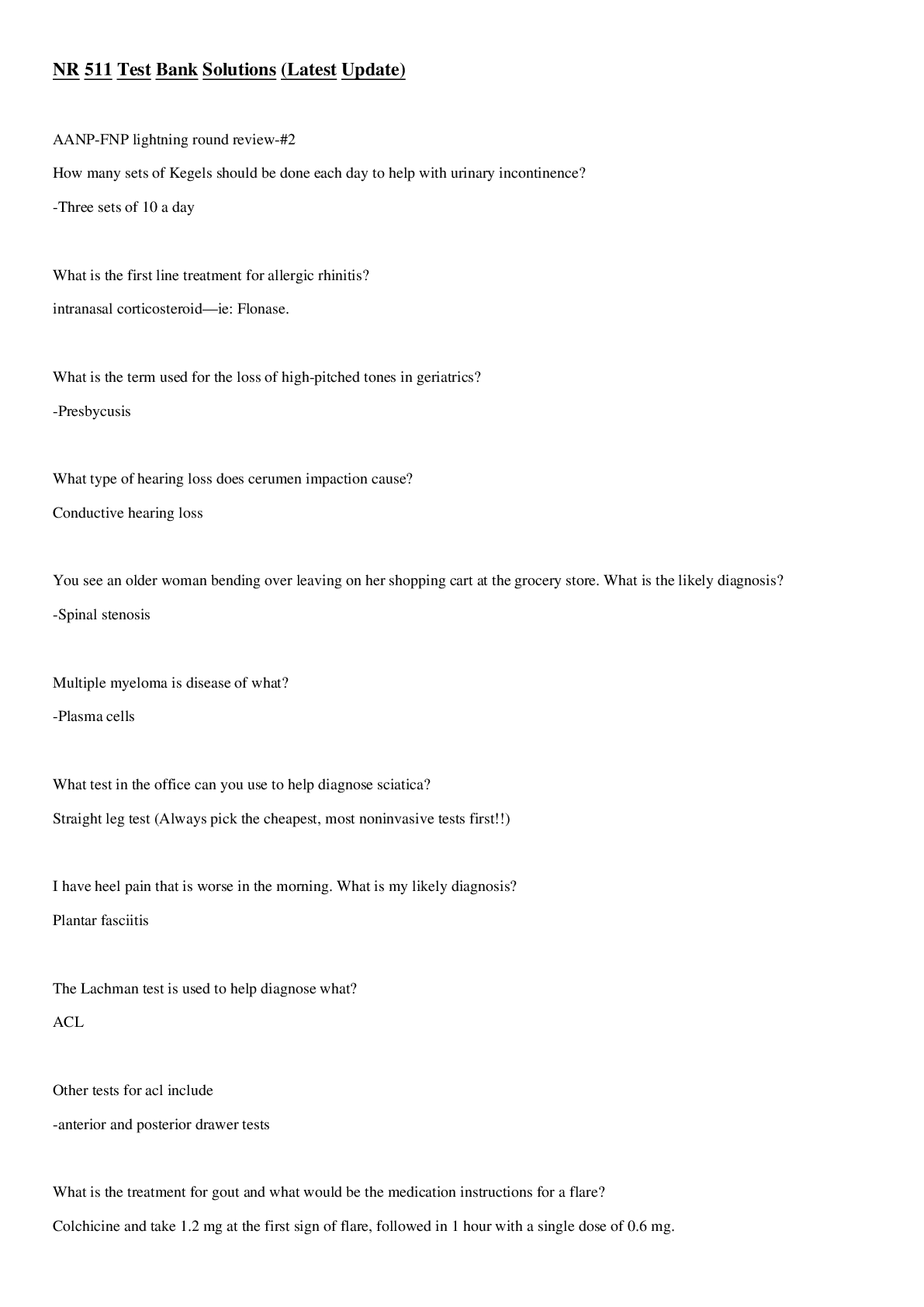


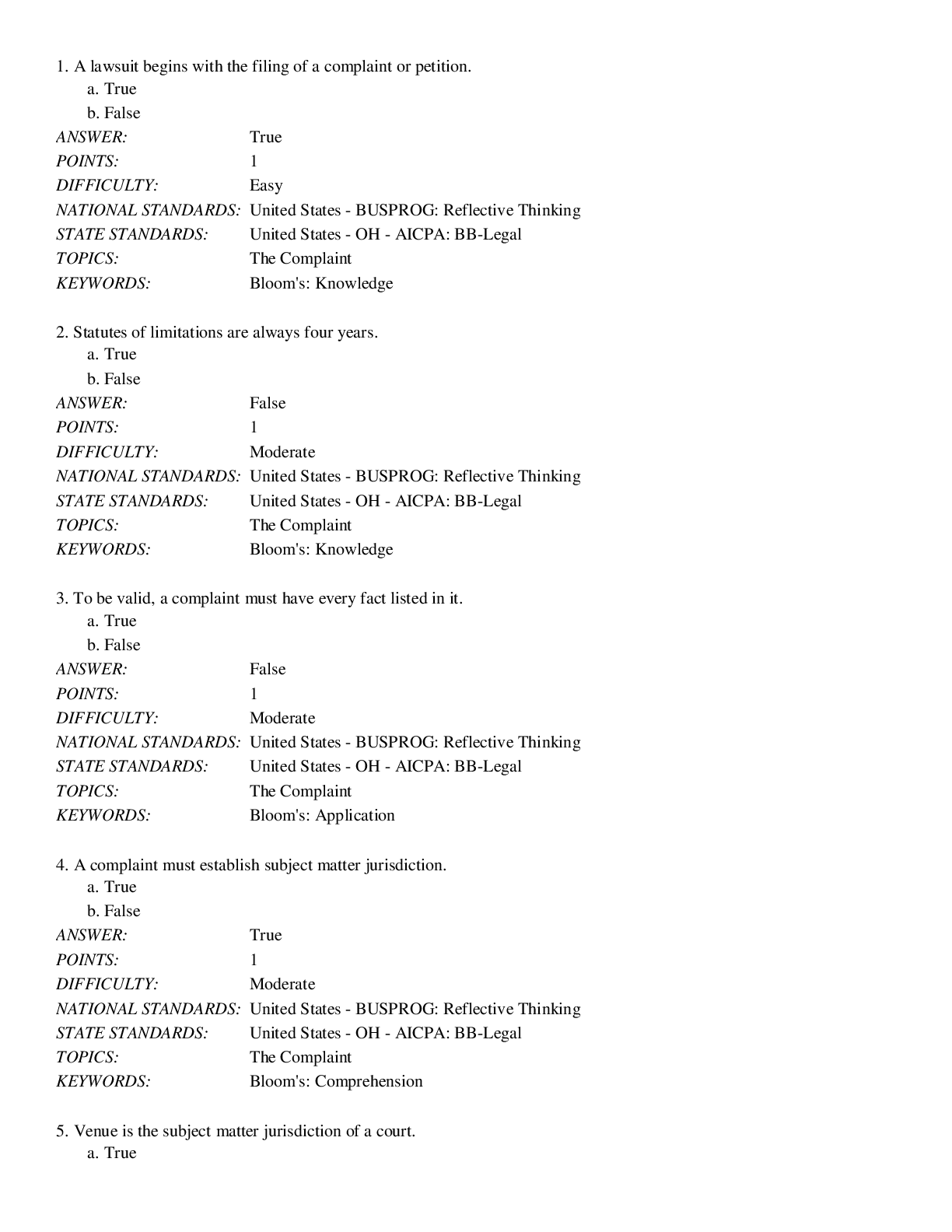


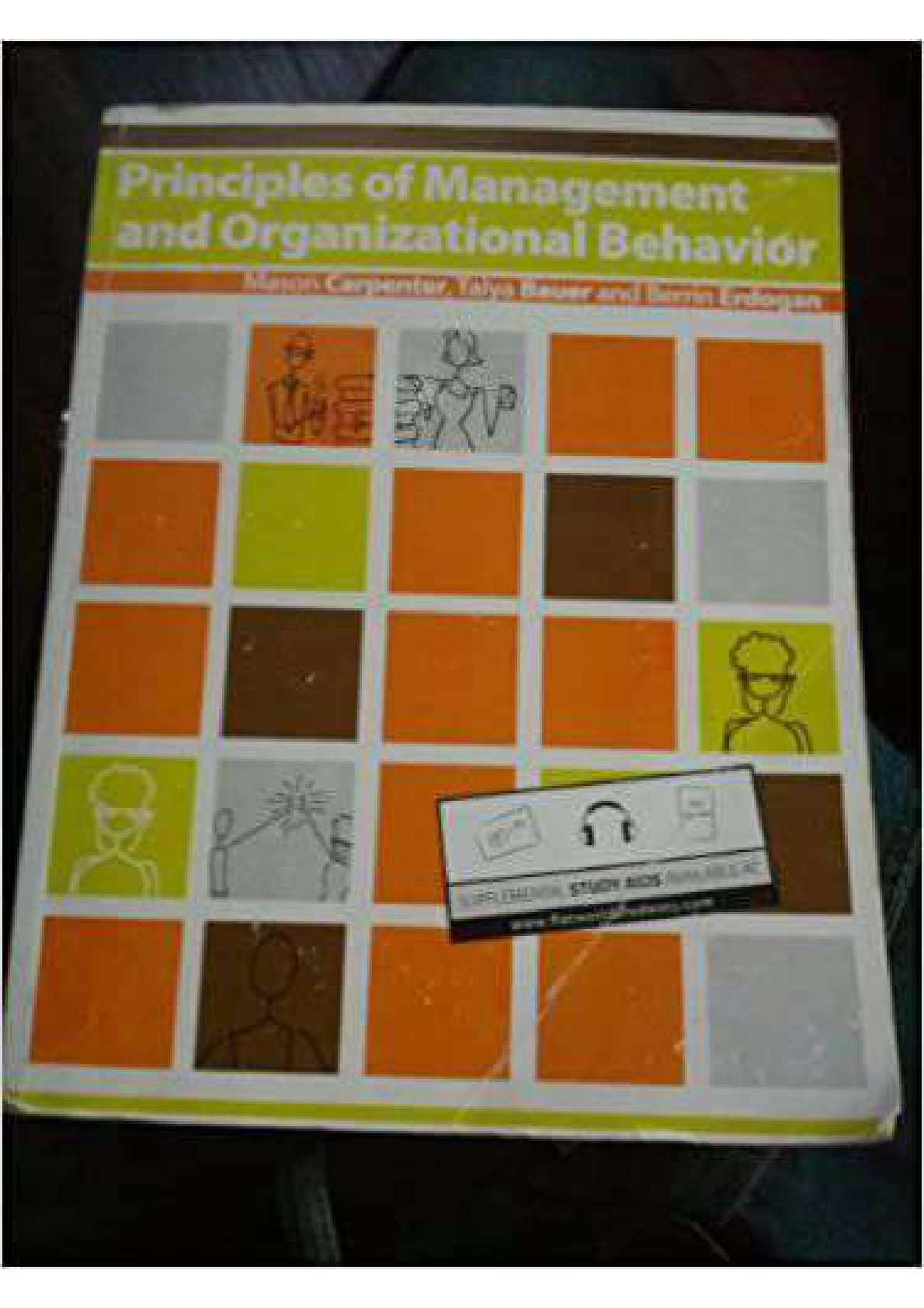

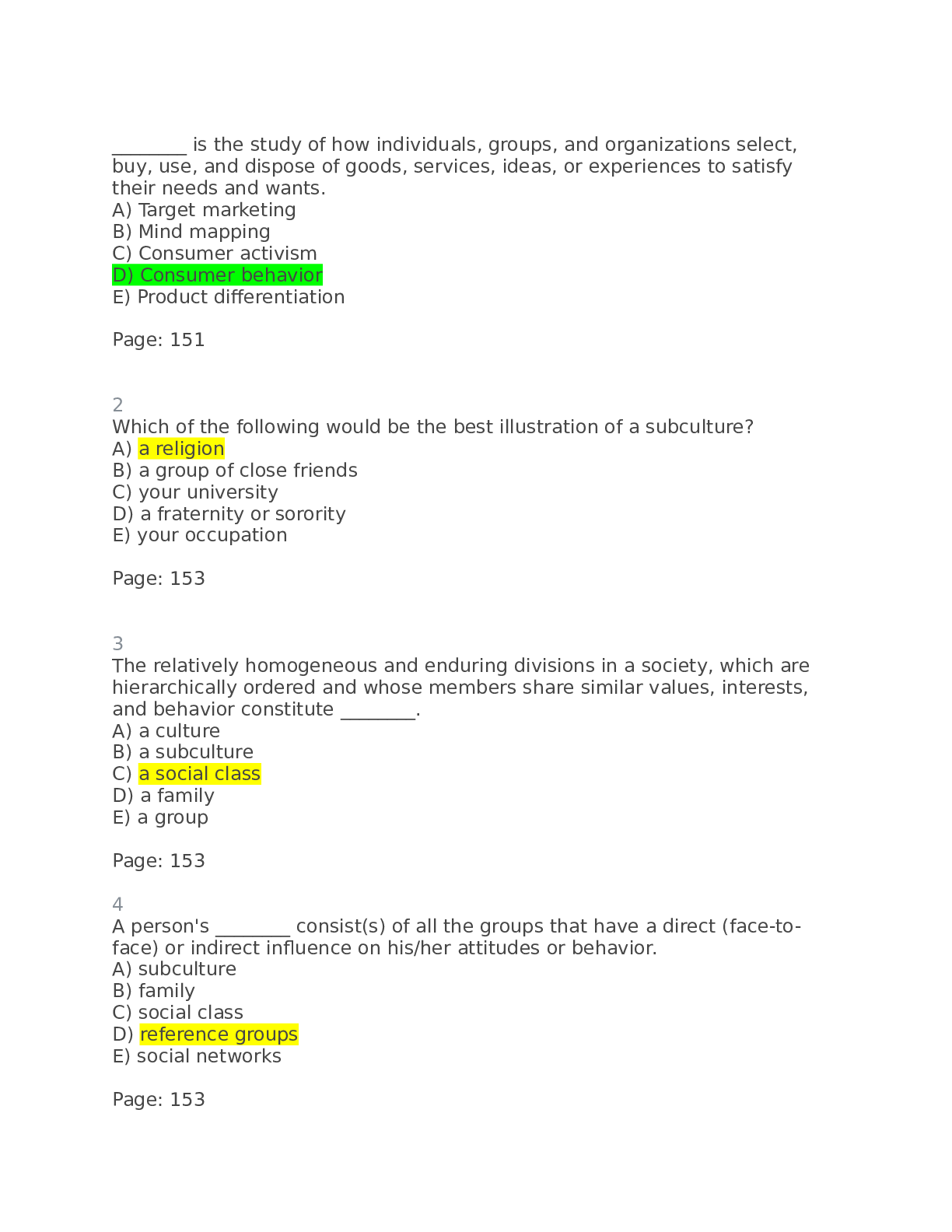
 Edition.png)


